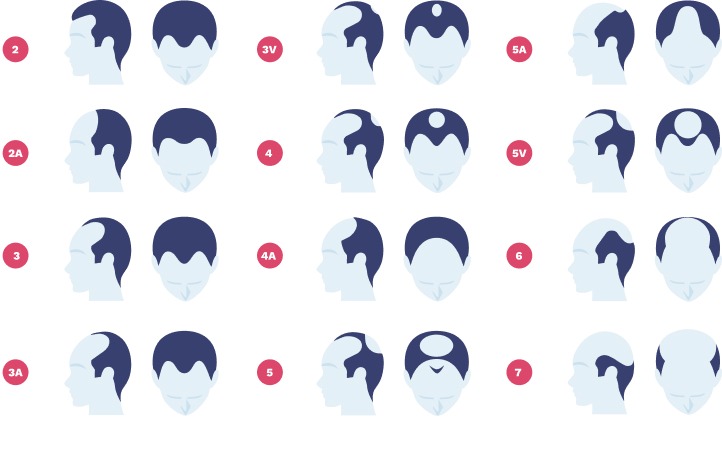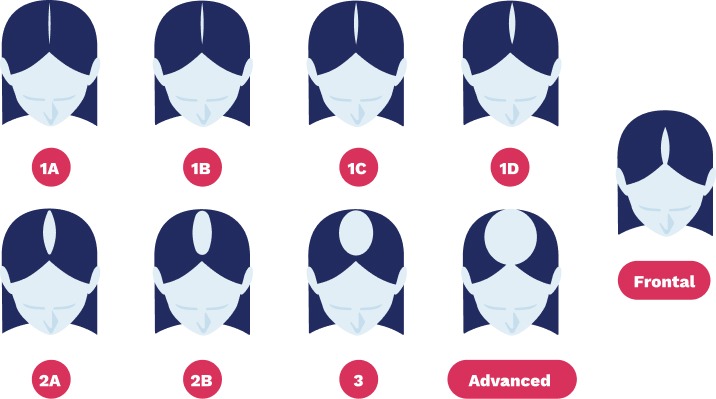HAIR LOSS BASICS
Understanding causes and effective treatments with Dr. Ken Anderson
In this comprehensive guide, we delve into the nuances of hair loss, shedding, and breakage – clarifying their distinctions and exploring the various underlying causes and treatments. Whether you’re noticing more hair on your brush or contemplating your options for hair restoration, you’ll find expert insights and solutions here to help you navigate the complex landscape of hair health. Join us as we offer up-to-date, evidence-based advice and advanced treatment strategies tailored to restoring not only your hair but also your confidence.
What is the difference between hair loss, shredding, and breakage?
“Hair loss, shedding, and breakage are terms often used interchangeably, but they refer to different phenomena,” explains Dr. Anderson.
Hair Loss
Medically known as alopecia, hair loss refers to the partial or complete lack of hair growth and is often progressive. In women, this is typically seen as a thinning of hair across the scalp, rather than a receding hairline or bald patches commonly observed in men. Hair loss can be because of various causes, including genetics, hormonal changes, or underlying health conditions.
Hair loss appears as a noticeable thinning of hair and sometimes bald patches. The hair you lose because of alopecia typically comes out from the root and will have a small white bulb at the end. If you’re seeing more scalp than before or if your ponytail has decreased in volume, it might be hair loss.
Shedding
Hair shedding is a part of the natural balance of the hair life cycle. Hair grows in phases: anagen (growth phase), catagen (transitional phase), and telogen (resting phase). At any given time, a healthy scalp will have hairs in all three phases and losing 50 to 100 hairs per day during the telogen phase is considered normal. Shedding becomes excessive and noticeable when the cycle is disrupted, often by stress, illness, or hormonal changes.
You might notice more hair in your brush or on your clothes in cases of excessive shedding, but this typically doesn’t result in noticeable thinning of your scalp hair or additional scalp visibility.
Breakage
Hair breakage occurs when strands become fragile and break off anywhere along the length of the hair, unlike shedding, where hair falls out from the root. Breakage is typically a result of external damage to the hair shaft from chemical treatments, heat styling, improper detangling, or other physical stressors. This type of hair loss does not affect the follicle itself but results in uneven hair length, frizziness, split ends, and/or reduced overall volume.
What causes hair loss?
Androgenetic Alopecia
If you have the most common type of hair loss, Androgenetic alopecia, your hair loss is caused by a combination of genetic predisposition and the influence of androgens, particularly dihydrotestosterone (DHT), on your hair follicles. Androgens are present in both males and females, although in different quantities. DHT contributes to the shrinking of hair follicles, making them unable to sustain normal hair growth cycles, leading to the characteristic pattern of hair loss seen in Androgenetic alopecia.
Androgenetic alopecia is also known as male or female pattern baldness because it typically follows distinct patterns of hair loss that are characteristic in men and women, as described by the Norwood and Ludwig scales, respectively.
The Norwood scale, commonly used to classify male pattern baldness, categorizes the progression of hair loss in men into several stages. It starts with a receding hairline at the temples (Norwood stage 1) and progresses to more extensive hair loss on the crown and frontal scalp, often leaving a horseshoe-shaped pattern of hair remaining at the sides and back of the head (Norwood stage 7).
On the other hand, the Ludwig scale is used to classify female pattern hair loss. It typically involves diffuse thinning of hair over the crown of the scalp, resulting in widening of the part line and overall reduction in hair density. Unlike male pattern baldness, female pattern hair loss rarely leads to complete baldness but can still significantly impact the appearance and self-esteem of affected individuals. Both scales serve as valuable tools for clinicians to assess the extent and progression of Androgenetic alopecia in men and women, aiding in treatment planning and management strategies.
Other Causes
Some other less common causes of hair loss include:
- Telogen effluvium is a form of temporary hair loss that typically occurs after stress, a shock, or a traumatic event. It usually involves the shedding of hair from all over the scalp rather than specific areas. The condition is characterized by an increased number of hairs entering the telogen phase, which is the resting stage of the hair growth cycle, leading to widespread thinning. Hair loss in telogen effluvium is usually reversible, with normal hair growth often resuming once the underlying cause is addressed. Common triggers include severe illness, major surgery, significant life stress, extreme weight loss, or changes in hormone levels.
- Alopecia areata is an autoimmune disorder characterized by sudden, patchy hair loss. In this condition, the immune system mistakenly attacks the hair follicles, leading to the loss of hair on the scalp and potentially other parts of the body, including eyebrows and eyelashes. The severity of hair loss can vary widely; some individuals may experience small, round patches of hair loss, while others may lose more extensive hair, or even all hair on the body, a condition known as alopecia universalis. The course of alopecia areata is unpredictable, and hair may regrow spontaneously in some cases. Treatment aims to suppress the immune response and stimulate hair regrowth.
- Traction alopecia is a form of hair loss caused by constant pulling or tension on the hair shafts, typically as a result of certain hairstyles that pull the hair tight, such as ponytails, braids, and dreadlocks. This condition is most commonly seen at the hairline—forehead, temples, and nape. The tension on the hair follicles can lead to damage over time, preventing new hair from growing and resulting in thinning or bald patches. If not addressed early, traction alopecia can lead to permanent hair loss because of the scarring of the hair follicles. To prevent and treat traction alopecia, try to avoid very tight hairstyles and to minimize the use of harsh chemicals and heat on the hair.
- Cicatricial alopecia, also known as scarring alopecia, is a rare group of conditions that cause hair follicles to be replaced with scar tissue, potentially leading to permanent hair loss. It can affect healthy individuals of any age and may progress slowly without noticeable symptoms or more quickly accompanied by mild discomfort, such as itching or tenderness. The causes of cicatricial alopecia are not entirely known, but they involve an inflammatory process that affects the hair follicles. Treatment aims to manage inflammation and prevent further scarring. With timely and effective treatment, many people successfully manage their condition.
What are the best ways to prevent hair loss?
Topical Minoxidil and/or Finasteride

Minoxidil, also known as Rogaine, is a medication commonly used to treat pattern hair loss (androgenetic alopecia) and is effective for both men and women. It is available over the counter in topical forms, such as liquids and foams. Minoxidil can also be combined with additional ingredients, such as finasteride (also known as Propecia), and made available via prescription.
“Topicals such as minoxidil and finasteride are particularly effective in the early stages of androgenetic alopecia,” Dr. Anderson advises. “Regular application can significantly help to stabilize shedding and even enhance regrowth.”
Dr. Anderson continued, “New research suggests that taking a vitamin D supplement can increase the efficacy of topical minoxidil. A study published in the Sohag Medical Journal indicates that vitamin D plays a critical role in hair follicle differentiation and cycling. Patients with female pattern hair loss (FPHL) have been found to have lower levels of serum vitamin D. Supplementing with vitamin D has been shown to improve the outcomes of topical minoxidil treatment, potentially leading to better stabilization of hair loss and enhanced regrowth.”
Low-Level Laser Therapy
Low-level laser therapy (LLLT) devices are FDA-cleared for the treatment of hair loss and the promotion of hair regrowth. These devices come in various forms, including combs, helmets, and caps, making them a convenient, non-invasive treatment option for those experiencing hair thinning and loss. They use lasers in the red to near-infrared range to stimulate hair follicles on the scalp. The light energy is believed to enhance cellular respiration and increase blood circulation, which may lead to increased nutrient delivery to the hair follicles. This process of photobiostimulation can potentially extend the growth phase of hair, slow down hair shedding, and increase the density and fullness of hair. Interested in learning more? Take a deeper dive into LLLT here.

Platelet-Rich Plasma
Platelet-Rich Plasma therapy involves the injection of a concentration of a patient’s own platelets directly into the scalp. “This is highly effective because it harnesses the natural growth factors in your blood, which can help rejuvenate follicles and stimulate hair growth,” says Dr. Anderson. Learn more about the science and the process by clicking here.

Oral Finasteride
Finasteride was originally developed to treat benign prostatic hyperplasia (BPH), but it was later found to be effective in treating male pattern hair loss, leading to its FDA approval for this purpose. This medication works by inhibiting the enzyme 5-alpha-reductase, which is responsible for converting testosterone into dihydrotestosterone (DHT). DHT is a key hormone involved in hair loss; it shrinks hair follicles, which eventually leads to baldness. By reducing DHT levels, finasteride can slow hair loss and, in some cases, promote hair regrowth. It is typically taken in pill form and is most effective in treating hair loss on the crown and in the middle of the scalp. Your doctor can prescribe finasteride during a complimentary consultation.
It is important to note that finasteride is not approved for use by women and can cause birth defects if used during pregnancy.

What should I do if I think I’m experiencing hair loss?
If you think you are experiencing hair loss, the first step is to seek professional advice to understand the underlying causes and explore appropriate treatment options. Most patients think to visit their dermatologist, but the vast majority of dermatologists do not have specialized training in treating hair loss.
“A complimentary consultation with a doctor who specializes in nothing but hair is the best first step to accurately determine the cause of your hair loss and to develop an effective treatment plan tailored to your specific needs,” Dr. Anderson advises. He adds, “We offer these consultations in person at our Atlanta and Alpharetta locations, as well as virtually, to ensure that everyone has access to expert advice regardless of their location.”
During a consultation, you can expect a thorough examination of your scalp and hair, a discussion about your medical history, and possibly some diagnostic tests. This comprehensive approach helps pinpoint whether hair loss is because of genetic factors, medical conditions, lifestyle habits, or other causes. Based on this assessment, a range of treatment options can be considered.
“The sooner you address the signs of hair loss, the more effective the treatments can be.” suggests Dr. Anderson.
How do I restore my hairline or fill in a bald spot?
It’s always better to prevent hair loss before it happens, but if you’ve already lost enough hair that it bothers you, it’s time to consider all your options. Hair restoration surgery can be a highly effective solution for many cases of hair loss. Dr. Ken Anderson points out, “Non-surgical treatments are meant to slow or pause the progression of hair loss. In some cases, these prevention tools and procedures can regrow hair. If you want to put back hair that is long lost, hair restoration might be an option you want to consider.”
Hair Restoration Surgery
Hair Restoration surgery is cosmetic procedure that involves transplanting individual hair follicles from the dense donor areas on the back and sides of the head, to thinner areas in the front and on top where it’s needed. At Anderson Center for Hair, we offer both the Follicular Unit Excision (FUE) and Follicular Unit Transplant (FUT) methods of surgery.
Hair restoration surgery, when done by an award-winning surgeon such as Dr. Anderson, offers permanent and natural-looking results.








